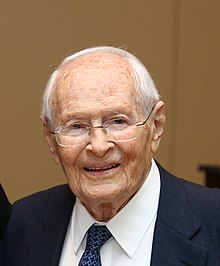George Rosenkranz | |
|---|---|
 George Rosenkranz receiving the Biotechnology Heritage Award in Chicago, 2013 | |
| Born | 20 August 1916 |
| Died | 23 June 2019 (aged 102) Atherton, California, U.S. |
| Nationality | Mexican[1] |
| Known for | Synthesis of norethisterone, the first orally highly active progestin, used in one of the first oral contraceptive pills |
| Scientific career | |
| Fields | Chemistry |
George Rosenkranz (born György Rosenkranz; 20 August 1916 – 23 June 2019) was a pioneering Hungarian-born Mexican scientist in the field of steroid chemistry, who used native Mexican plant sources as raw materials.[2][3] He was born in Hungary, studied in Switzerland and emigrated to the Americas to escape the Nazis, eventually settling in Mexico.[2][4]
At Syntex corporation in Mexico City, Rosenkranz assembled a research group of organic chemists that included future leaders from around the world, such as Carl Djerassi, Luis E. Miramontes and Alejandro Zaffaroni.[5][6][7][8][9][10] Revolutionary advances in the understanding of steroid drugs and their production occurred under Dr Rosenkranz's direction.[11] Syntex synthesized a progestin used in some of the first combined oral contraceptive pills and numerous other useful steroids. Under Rosenkranz's leadership, Syntex became "a powerful international force in the development of steroidal pharmaceuticals",[12] and "a pioneer of biotechnology" in the San Francisco Bay Area. Rosenkranz stepped down as CEO in 1982, at the age of 65.[13]
In 2012, he was awarded the Biotechnology Heritage Award, in recognition of his significant contributions to the development of biotechnology through discovery, innovation, and public understanding.[8] He turned 100 in August 2016.[14]
Rosenkranz was also an American Contract Bridge League (ACBL) Grand Life Master at his hobby of duplicate bridge, with more than 13,000 masterpoints and 12 NABC titles (below). He wrote or co-wrote more than 10 books on bridge.[15]
- ^ "La píldora anticonceptiva, ¿es de 'padres' mexicanos?". Excélsior. 2014-03-10. Retrieved 30 May 2015.
Rosenkranz se nacionalizó mexicano, siguió trabajando en Syntex por muchos años, actualmente vive en México y tiene 98 años.
- ^ a b Ness, Roberta B. (2013). Genius unmasked. Oxford: Oxford Univ. Press. ISBN 9780199976591.
- ^ Cite error: The named reference
ScientistsYouMustKnowwas invoked but never defined (see the help page). - ^ Cohen, Gerald S. (2002). "Mexico's Pill Pioneer". Perspectives in Health Magazine: The Magazine of the Pan American Health Organization. 7 (1). Retrieved 6 February 2014.
- ^ Cite error: The named reference
Kornbergwas invoked but never defined (see the help page). - ^ USA Science & Engineering Festival – Role Models in Science & Engineering Achievement Archived 2014-08-06 at the Wayback Machine. Retrieved 1 Oct 2014.
- ^ Juaristi, Eusebio (2 May 2003). "A few comments on the development of organic chemistry in Mexico". Arkivoc. 2003 (11): 1–3. doi:10.3998/ark.5550190.0004.b01. hdl:2027/spo.5550190.0004.b01. Retrieved 15 May 2014.
- ^ a b Cite error: The named reference
BioAwardwas invoked but never defined (see the help page). - ^ Morell, Virginia (23 January 1989). "Rewards Of Intellectual Bigamy". The Scientist. Retrieved 16 May 2014.
- ^ "American Chemical Society International Historic Chemical Landmarks. The "Marker Degradation" and Creation of the Mexican Steroid Hormone Industry 1938–1945". American Chemical Society. Retrieved 15 May 2014.
- ^ "Steroid pioneer gets Heritage Foundation, BIO award". BioSpectrum. 22 April 2013. Archived from the original on 3 May 2013. Retrieved 7 February 2014.
- ^ Raber, Linda (25 October 1999). "Steroid Industry Honored". ACS News. 77 (43): 78–80.
- ^ Cite error: The named reference
CHFOralHistorywas invoked but never defined (see the help page). - ^ Staff (2016-07-12). "Honoring The 100th Birthday of George Rosenkranz, PH.D." congress.gov. Retrieved 2016-08-21.
- ^ "Rosenkranz, George". Hall of Fame. American Contract Bridge League (ACBL). Archived from the original on 17 September 2016. Retrieved 18 December 2014.